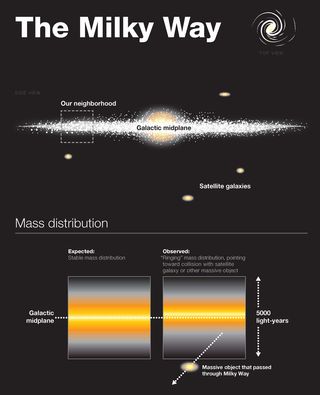Mystery Wave in Milky Way Galaxy Suggests Recent Crash

A mysterious wave discovered in the Milky Way suggests our galaxy is still ringing like a bell from a galactic collision, a crash that possibly occured within the last 100 million years, scientists say.
Astronomers discovered that stars north and south of the midplane of the galaxy are distributed differently, suggesting that some recent event perturbed them. The most likely explanation is that a small satellite galaxy or clump of invisible dark matter plowed through the Milky Way, leaving behind the echoes that we see.
"Our part of the Milky Way is ringing like a bell," Brian Yanny, of the Fermi National Accelerator Laboratory (Fermilab) in Batavia, Ill., said in a statement. "But we have not been able to identify the celestial object that passed through the Milky Way. It could have been one of the small satellite galaxies that move around the center of our galaxy, or an invisible structure such as a dark matter halo."
The wave was discovered in data from the Sloan Digital Sky Survey, which has observed roughly 300,000 nearby Milky Way stars.
"We have found evidence that our Milky Way had an encounter with a small galaxy or massive dark matter structure perhaps as recently as 100 million years ago," said Larry Widrow, a professor at Queen’s University in Canada. "We clearly observe unexpected differences in the Milky Way’s stellar distribution above and below the Galaxy's midplane that have the appearance of a vertical wave — something that nobody has seen before."

About 60 miniature "dwarf galaxies" have been discovered orbiting the Milky Way. Theory suggests that many invisible dark matter satellites also circle our galaxy, though these would only be detectable by their gravitational pull.
It's likely that one of these may have slammed into the Milky Way, though even that is not certain.
Get the Space.com Newsletter
Breaking space news, the latest updates on rocket launches, skywatching events and more!
"The perturbation need not have been a single isolated event in the past, and it may even be ongoing," said Susan Gardner of the University of Kentucky. "Additional observations may well clarify its origin."
The research is detailed in a recent edition of the Astrophysical Journal Letters.
Follow SPACE.com on Twitter @Spacedotcom. We're also on Facebook & Google+.
Join our Space Forums to keep talking space on the latest missions, night sky and more! And if you have a news tip, correction or comment, let us know at: community@space.com.

Space.com is the premier source of space exploration, innovation and astronomy news, chronicling (and celebrating) humanity's ongoing expansion across the final frontier. Originally founded in 1999, Space.com is, and always has been, the passion of writers and editors who are space fans and also trained journalists. Our current news team consists of Editor-in-Chief Tariq Malik; Editor Hanneke Weitering, Senior Space Writer Mike Wall; Senior Writer Meghan Bartels; Senior Writer Chelsea Gohd, Senior Writer Tereza Pultarova and Staff Writer Alexander Cox, focusing on e-commerce. Senior Producer Steve Spaleta oversees our space videos, with Diana Whitcroft as our Social Media Editor.